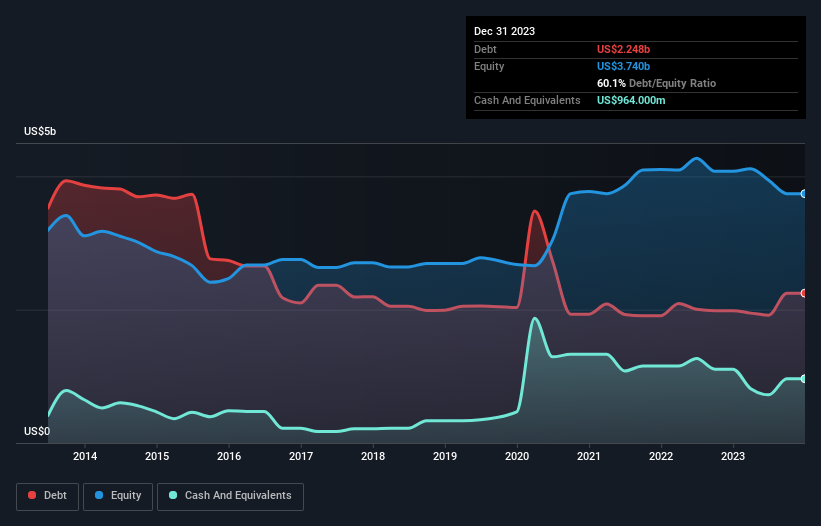- United States
- /
- Metals and Mining
- /
- NYSE:AU
Here's Why AngloGold Ashanti (NYSE:AU) Has A Meaningful Debt Burden

David Iben put it well when he said, 'Volatility is not a risk we care about. What we care about is avoiding the permanent loss of capital.' It's only natural to consider a company's balance sheet when you examine how risky it is, since debt is often involved when a business collapses. We note that AngloGold Ashanti plc (NYSE:AU) does have debt on its balance sheet. But should shareholders be worried about its use of debt?
Why Does Debt Bring Risk?
Debt and other liabilities become risky for a business when it cannot easily fulfill those obligations, either with free cash flow or by raising capital at an attractive price. If things get really bad, the lenders can take control of the business. However, a more frequent (but still costly) occurrence is where a company must issue shares at bargain-basement prices, permanently diluting shareholders, just to shore up its balance sheet. Of course, the upside of debt is that it often represents cheap capital, especially when it replaces dilution in a company with the ability to reinvest at high rates of return. When we examine debt levels, we first consider both cash and debt levels, together.
View our latest analysis for AngloGold Ashanti
What Is AngloGold Ashanti's Debt?
As you can see below, at the end of December 2023, AngloGold Ashanti had US$2.25b of debt, up from US$1.99b a year ago. Click the image for more detail. However, because it has a cash reserve of US$964.0m, its net debt is less, at about US$1.28b.

How Strong Is AngloGold Ashanti's Balance Sheet?
According to the last reported balance sheet, AngloGold Ashanti had liabilities of US$1.21b due within 12 months, and liabilities of US$3.23b due beyond 12 months. Offsetting these obligations, it had cash of US$964.0m as well as receivables valued at US$300.0m due within 12 months. So its liabilities outweigh the sum of its cash and (near-term) receivables by US$3.17b.
AngloGold Ashanti has a very large market capitalization of US$10.6b, so it could very likely raise cash to ameliorate its balance sheet, if the need arose. However, it is still worthwhile taking a close look at its ability to pay off debt.
We measure a company's debt load relative to its earnings power by looking at its net debt divided by its earnings before interest, tax, depreciation, and amortization (EBITDA) and by calculating how easily its earnings before interest and tax (EBIT) cover its interest expense (interest cover). Thus we consider debt relative to earnings both with and without depreciation and amortization expenses.
AngloGold Ashanti has a low net debt to EBITDA ratio of only 1.1. And its EBIT easily covers its interest expense, being 142 times the size. So we're pretty relaxed about its super-conservative use of debt. In fact AngloGold Ashanti's saving grace is its low debt levels, because its EBIT has tanked 30% in the last twelve months. When a company sees its earnings tank, it can sometimes find its relationships with its lenders turn sour. The balance sheet is clearly the area to focus on when you are analysing debt. But ultimately the future profitability of the business will decide if AngloGold Ashanti can strengthen its balance sheet over time. So if you want to see what the professionals think, you might find this free report on analyst profit forecasts to be interesting.
Finally, while the tax-man may adore accounting profits, lenders only accept cold hard cash. So we always check how much of that EBIT is translated into free cash flow. Over the last three years, AngloGold Ashanti reported free cash flow worth 19% of its EBIT, which is really quite low. For us, cash conversion that low sparks a little paranoia about is ability to extinguish debt.
Our View
AngloGold Ashanti's EBIT growth rate and conversion of EBIT to free cash flow definitely weigh on it, in our esteem. But its interest cover tells a very different story, and suggests some resilience. When we consider all the factors discussed, it seems to us that AngloGold Ashanti is taking some risks with its use of debt. While that debt can boost returns, we think the company has enough leverage now. While AngloGold Ashanti didn't make a statutory profit in the last year, its positive EBIT suggests that profitability might not be far away. Click here to see if its earnings are heading in the right direction, over the medium term.
Of course, if you're the type of investor who prefers buying stocks without the burden of debt, then don't hesitate to discover our exclusive list of net cash growth stocks, today.
New: Manage All Your Stock Portfolios in One Place
We've created the ultimate portfolio companion for stock investors, and it's free.
• Connect an unlimited number of Portfolios and see your total in one currency
• Be alerted to new Warning Signs or Risks via email or mobile
• Track the Fair Value of your stocks
Have feedback on this article? Concerned about the content? Get in touch with us directly. Alternatively, email editorial-team (at) simplywallst.com.
This article by Simply Wall St is general in nature. We provide commentary based on historical data and analyst forecasts only using an unbiased methodology and our articles are not intended to be financial advice. It does not constitute a recommendation to buy or sell any stock, and does not take account of your objectives, or your financial situation. We aim to bring you long-term focused analysis driven by fundamental data. Note that our analysis may not factor in the latest price-sensitive company announcements or qualitative material. Simply Wall St has no position in any stocks mentioned.
About NYSE:AU
AngloGold Ashanti
Operates as a gold mining company in Africa, Australia, and the Americas.
High growth potential with excellent balance sheet.
Similar Companies
Market Insights
Community Narratives


